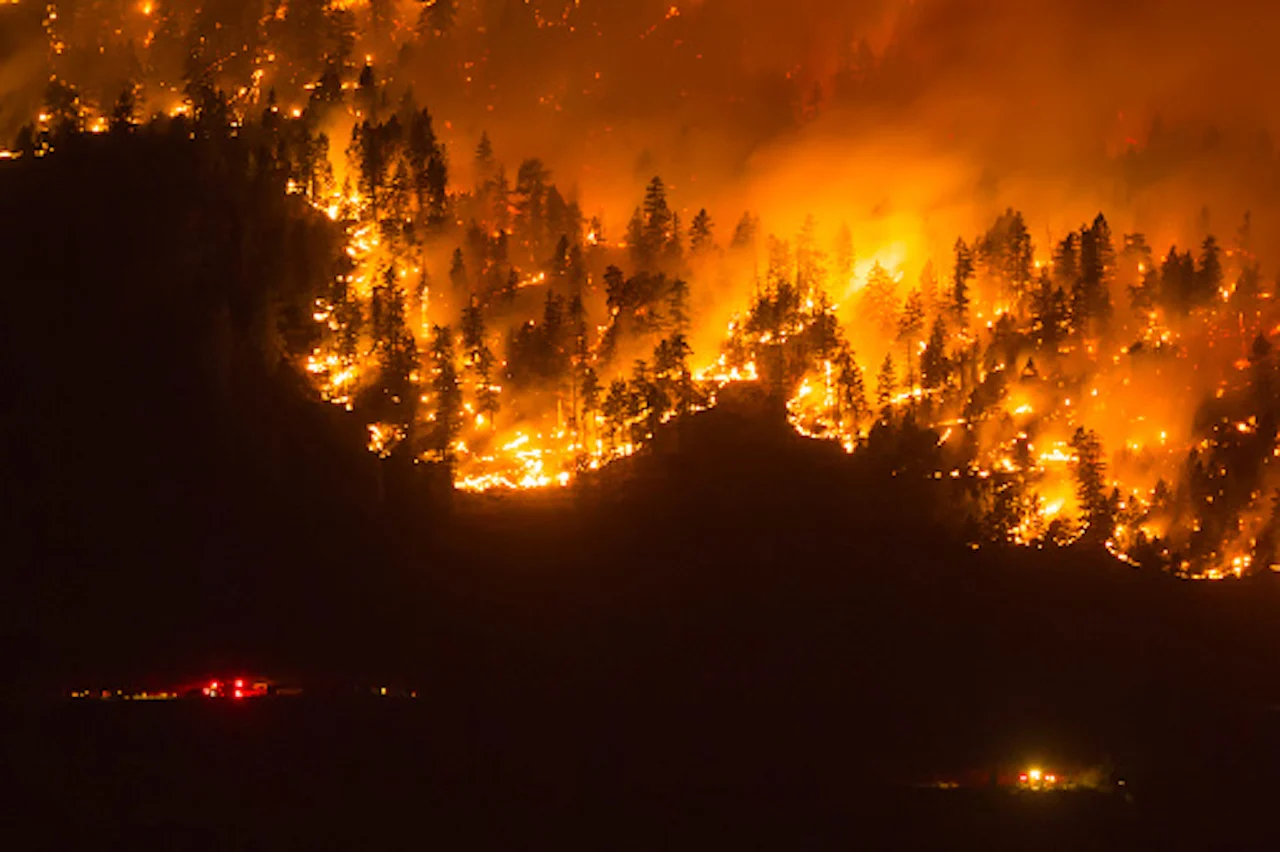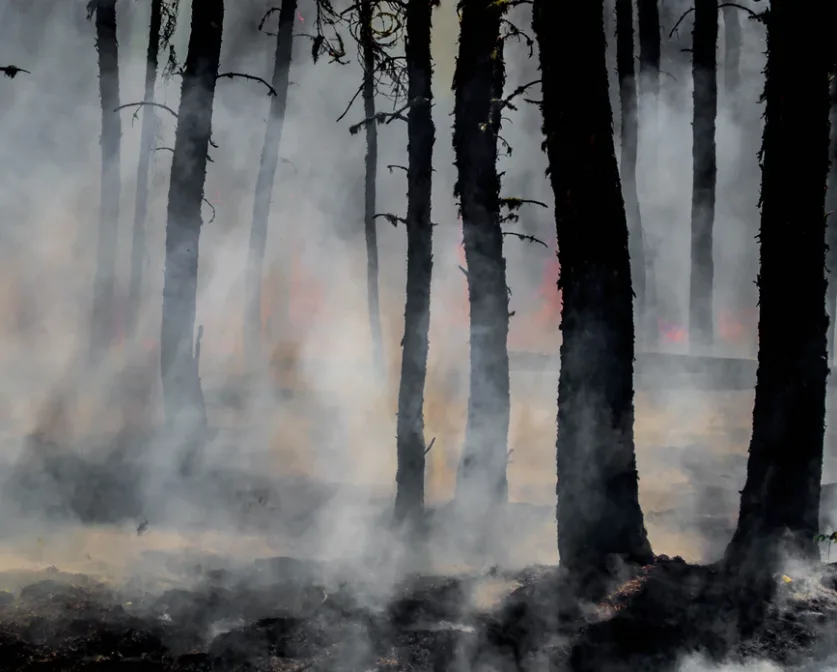
'This is not normal': Alberta suffered second worst wildfire season on record
NASA scientist Kate Marvel says that the rapid speed of the changing climate is "disturbing," but the science does not support inevitable doom.
Alberta's scorching wildfire season, which came to an end on October 31, was the second-worst wildfire season in the province's history and saw approximately 884,000 hectares burned -- an area that is ten times the size of Calgary.
This severe wildfire season comes just one year after British Columbia experienced its worst wildfire season on record with nearly 1.3 million hectares burned in 2018. An increasing number of scientists are stating that this is not a coincidence -- warming global temperatures are directly contributing to the increasing frequency and severity of wildfires in Western Canada and the Prairies.
Mike Flannigan, professor of Wildland Fire at the University of Alberta says the area burned in Canada by wildfires each year has doubled since the 1970s and this is the result of human-caused climate change.
"I can't be any more clearer than that, it is human-caused climate change and this is not normal, it is a new reality," says Flannigan.

The aftermath of the High Level wildfire in Alberta. Credit: Kevin MacKay
In Canada, just 3 per cent of all wildfires are responsible for 97 per cent of the total area burned, with this season being no exception in Alberta. Just two of the 989 recorded wildfires this season were responsible for 70 per cent of the total area burned, with the largest four wildfires being responsible for 85 per cent of the total area burned.
While the overall number of wildfires was slightly below the five-year average, the total area burned was over three times higher than normal and research indicates that this fire behaviour could become more common in the future.
HOW DOES CLIMATE CHANGE IMPACT WILDFIRES?
Several factors influence where wildfires start, how long they burn for, and how intense they become. Fuel, ignition, and weather influence wildfires and all three factors are being impacted by the warming climate.
Canada's federal climate change report concludes that the Prairie provinces have seen a 1.9°C increase in average annual temperature, and the warmer, drier conditions have increased the stockpile of fuel. Ignition is what starts the wildfire and the warming weather is increasing the frequency of lightning, as 10 to 12 per cent more strikes occur for each degree of warming.
Fire weather, which is a combination of unusual heat, low humidity, minimal to no precipitation, high winds and extreme weather during the summer months has also become more frequent. Research shows that snow is melting early in late winter and early spring, and seasonal average temperatures are rising, which creates hotter and drier conditions.
HOW DO WE KNOW HUMAN ACTIVITY IS TO BLAME?
The significant relationship between greenhouse gas emissions, such as carbon dioxide, that have been emitted by humans and the rise in global temperatures is the most commonly cited evidence for climate change.
Long term trends of declining sea ice, increasing frequency of extreme weather events, and rising sea levels all indicate that entire ecosystems are being negatively impacted and a study on tree rings and climate change confirms the projections that have been calculated by climate models.
SEE ALSO: Hundreds of 'fire feasters' swarm charred High Level forest
Dr. Kate Marvel, an associate research scientist at the Earth Institute and NASA's Goddard Institute for Space Studies, is the lead author of the study that analyzes tree rings and climate change and explains that the research correlates the increase in greenhouse gases since the early 1900s with global drought conditions.
Tree rings, which are visible on tree stumps, indicate what the weather was like during each year. Wide tree rings indicate that ideal conditions including ample warmth and moisture occurred that year, while thinner rings suggest that the tree experienced stressful weather conditions, such as drought.
Alternate sources of environmental information, such as ice cores and lakebed pollen, are necessary for understanding past climates since many regions only have weather records for a few decades or less than 150 years. Trees that are hundreds of years old can provide climate data for many centuries, while carbon dioxide captured in ice can help scientists generate continuous reconstructions of the past climate that go back at least 800,000 years.
Dr. Marvel explains that historical tree ring data provided insight into drought conditions over the past few centuries, and the 'fingerprint of human influence' began to emerge because of the influence of carbon dioxide on increasing drought conditions.

Smoke and glowing embers dominated the forest as wildland firefighters battled the last of the flames of the Harding Fire in north east Saskatchewan in 2017. Credit: Joanne Francis
"We are not saying that any particular drought was caused by climate change or human influence, we are saying that if you think of climate change as a background note against the symphony, you can hear that note as early as the first half of the 20th century," says Dr. Marvel.
WHY ARE FORESTS AT RISK WITH WARMING GLOBAL TEMPERATURES?
While wildfires are a normal function of forests and are critical for healthy ecosystems, the rapid changes in both wildfire behaviour and the climate could hinder the ability of some tree species from adapting to the new conditions after the wildfires burn out.
Dr. Marvel explains that this speed of change is "disturbing," because it means that climate change could contribute to massive biodiversity loss with one million species being at risk of extinction. Forests play a significant role in capturing large amounts of carbon dioxide from the atmosphere, and the increasing rate and intensity of wildfires could negatively impact their ability to store carbon.
When asked if we should be worried about finding a solution for what seems to be an impossible problem to solve, Dr. Marvel says that "the science does not support inevitable doom, and I take the exact opposite message from the science. We know exactly what is causing climate change and what is warming up the planet, which means we know exactly how to stop it."
The majority of climate scientists emphasize that greenhouse gas emissions released by humans must rapidly decline, and it cannot be done without government action.
"When people ask me what they can do to fight climate change I say that the number one thing you can do is vote, and the second most important thing is you can organize because politicians aren't going to take this seriously unless we make them take this seriously," says Dr. Marvel.
With files from Kyle Brittain.







